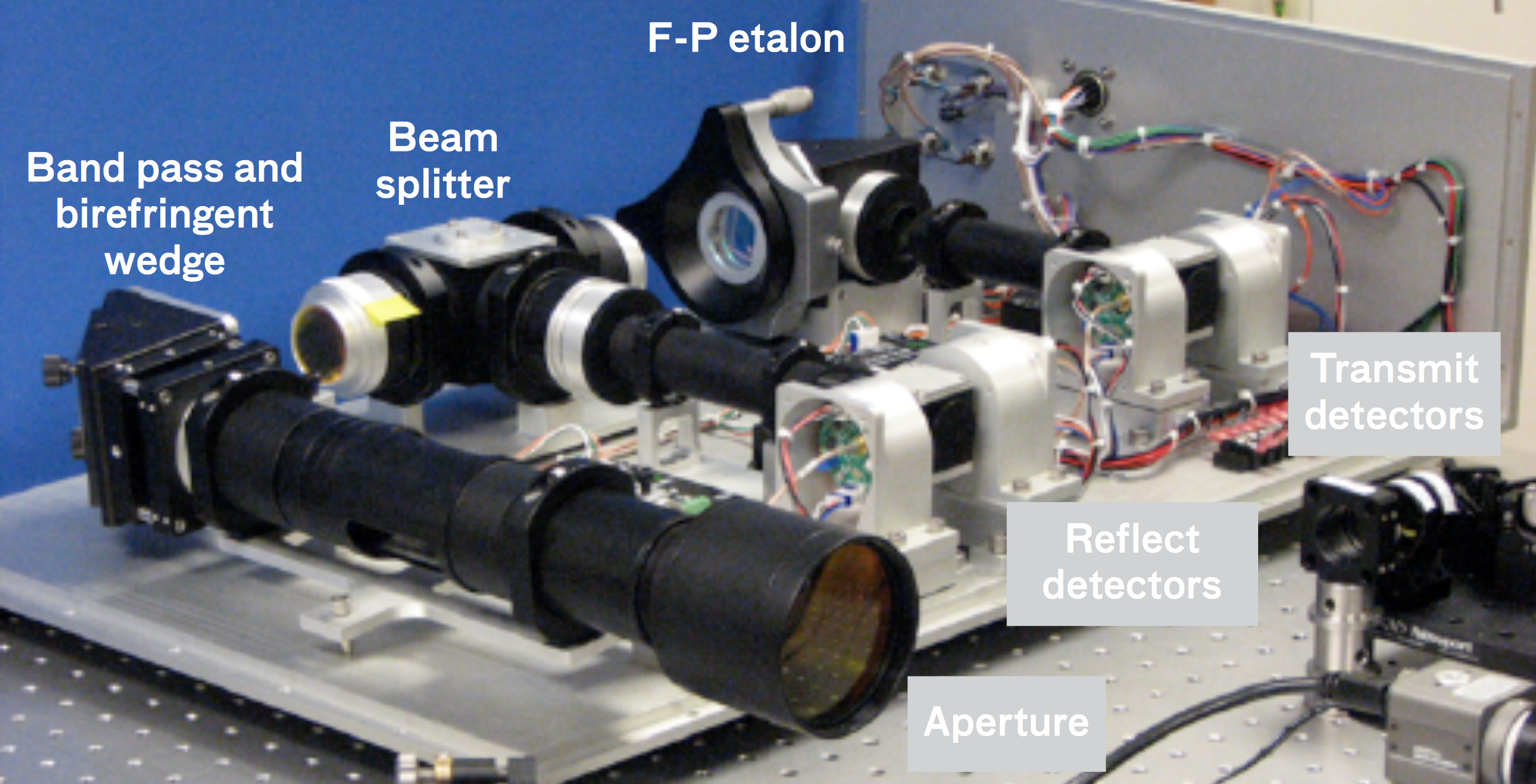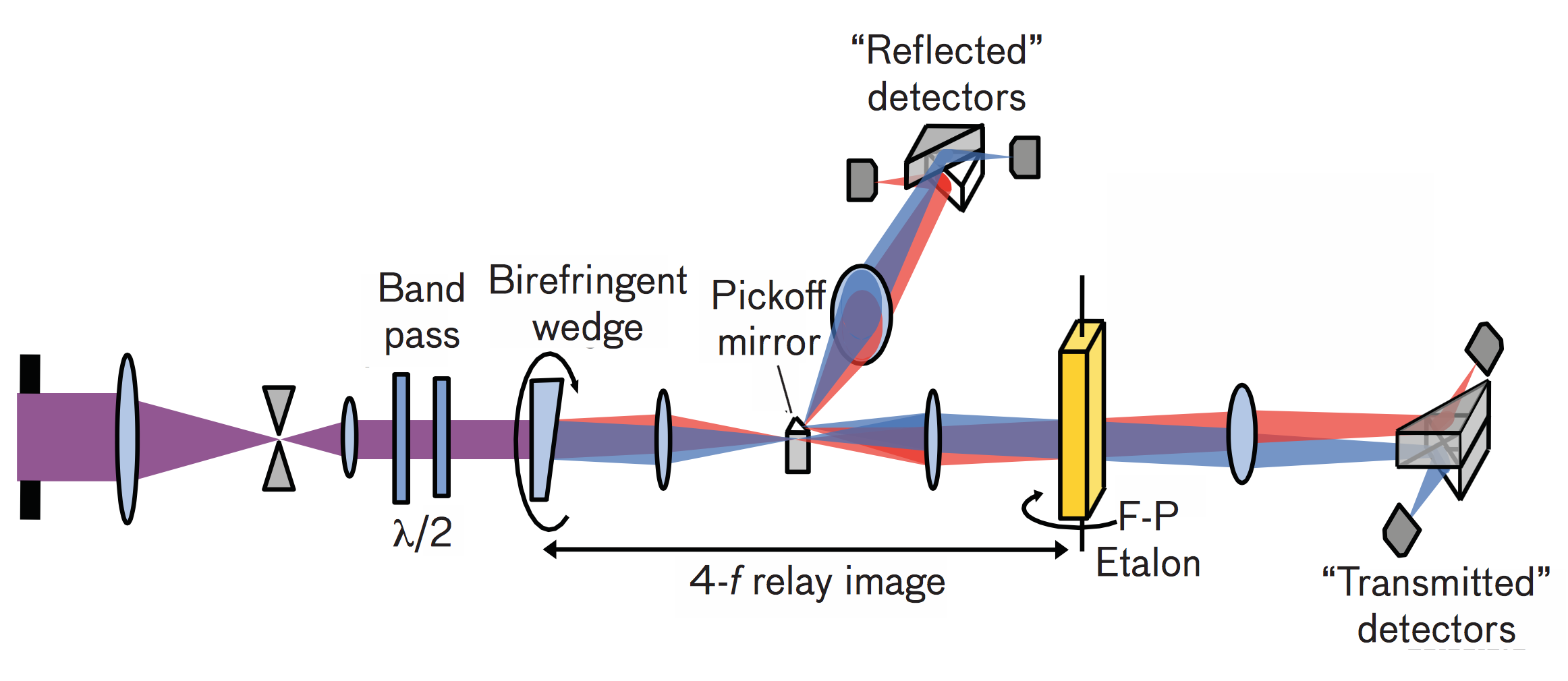Tech notes
Wide-Area Chemical Sensor
A highly sensitive sensor rapidly detects and measures concentrations of target gas molecules within the atmosphere at long ranges to warn of potentially hazardous chemical releases.
The detection and localization of gas releases such as methane from leaking natural gas pipelines or nitrogen oxides from failing electrical equipment require high sensitivity to the target gas and insensitivity to non-target gases. Infrared (IR) absorption spectroscopy gives highly specific characterization of the identity and the amount of airborne chemicals. Traditionally, spectroscopy techniques for long-range chemical sensing separate the "sensitive to x gas" and "insensitive to x gas" atmospheric measurements by quickly switching back and forth between them to reduce errors caused by any atmospheric changes. Because the samples are not measured at the same time, it is impossible to ensure that all atmospheric conditions (e.g., contaminants or humidity) remain constant between the two measurements.
 The WACS optical receiver has three major subcomponents: the angle-tunable beamsplitter and associated relay telescope to provide two angle-tuned optical paths, the Fabry-Pérot (F-P) etalon assembly that translates the angle tuning into spectral tuning, and the detector assembly that provides the four spectral measurements to yield two power-insensitive spectral ratios.
The WACS optical receiver has three major subcomponents: the angle-tunable beamsplitter and associated relay telescope to provide two angle-tuned optical paths, the Fabry-Pérot (F-P) etalon assembly that translates the angle tuning into spectral tuning, and the detector assembly that provides the four spectral measurements to yield two power-insensitive spectral ratios.The Wide-Area Chemical Sensor (WACS) addresses the problem of temporal atmospheric variation by taking the measurements concurrently; this approach compensates for spectral drift, atmospheric contaminants, and atmospheric scintillation, while simplifying the technical requirements of the laser (e.g., stability, power).
WACS Technique
The WACS system uses a spectrally self-referencing technique to decouple the target gas from the background atmo- sphere. The system consists of a reconfigurable 3.2–3.8 µm wavelength laser source, with 5 GHz linewidth and ~30 MHz wavelength stability, that is tunable to the target gas species, and a self-referencing detector that is tuned to the laser source. The laser operates at a 10 kHz repetition rate and an average transmit power of 3 mW. Any laser source with a linewidth commensurate with the target gas absorption width and with sufficient power could be substituted. WACS uses reference gas cells, such as methane buffered by nitrogen, and a low-concentration gas cell that contains the target species to calibrate the transmitter laser tuning and to verify gas sensitivity and specificity.
To detect and discriminate gas clouds, a single, relatively broadband laser source is transmitted through the atmosphere, and the laser's spectral deformation by the material it passes through is measured in a receiver. The deformations are matched to targeted materials, enabling the detection and discrimination of gas clouds at very low concentrations (~1 part per trillion by volume) over tens of kilometers. A second sensor not tuned to the particles of interest corrects for false alarms caused by atmospheric turbulence, variable atmospheric transmission, and other non-target gases.
The ability to separate light that "sees" the gas of interest from light that "does not see" requires a very narrow, tunable, and stable spectral filter; for this purpose, the WACS system uses a Fabry-Pérot etalon, a single lossless resonant cavity that consists of two partially reflective facing mirrors. The etalon transmission varies strongly with wavelength and with the angle at which the light strikes the etalon. Typical etalons can exhibit transmission bands of 10 MHz–100 GHz, and the band is tunable by varying the mirror reflectivity and spacing between the mirrors. The WACS system uses one phys- pass ical etalon, but sends light through at two distinct angles to produce two nearly identical but spectrally shifted filters that, by advent of being of the same physical device, stay spectrally locked to each other. Locking the two filters makes it easier to distinguish spectral changes that are due to the target of interest (in the case of correlated spectral changes) or contaminants or source drift (in the case of anticorrelated spectral changes).
All light encountering the cavity transmits through it or reflects off it; comparing these two light intensities enables measurement of the gas-induced absorption. This absorption varies over the bandwidth of the optical cavity's spectral response because of time-varying but spectrally constant losses caused by atmospheric scintillation and atmospheric contaminants.
 With its birefringement wedge and Fabry-Pérot (F-P) etalon, the WACS receiver is the primary system component that provides high sensitivity and stability, independent of any extraneous atmospheric conditions. The "see phase alpha" and "not see phase alpha" wavelengths are angle split by the wedge; the etalon takes the two angle-separated beams and converts them to spectrally split components. Spectral sensitivity of the WACS receiver relies on the paired etalon passbands—one for the light absorbed by the gas of interest and one for the light that is not absorbed. The two etalon passbands are slightly offset to the red and blue sides of the pulse spectrum to allow for compensation of spectral drift and atmospheric variations.
With its birefringement wedge and Fabry-Pérot (F-P) etalon, the WACS receiver is the primary system component that provides high sensitivity and stability, independent of any extraneous atmospheric conditions. The "see phase alpha" and "not see phase alpha" wavelengths are angle split by the wedge; the etalon takes the two angle-separated beams and converts them to spectrally split components. Spectral sensitivity of the WACS receiver relies on the paired etalon passbands—one for the light absorbed by the gas of interest and one for the light that is not absorbed. The two etalon passbands are slightly offset to the red and blue sides of the pulse spectrum to allow for compensation of spectral drift and atmospheric variations.Benefits of WACS
The WACS technique enables the measurement of concentrations of specified target gases within the atmosphere at longer ranges than those achieved by other active optical techniques, while using a much lower-power laser source for a given range. Additionally, WACS is capable of at least five times the absolute sensitivity of other sensors at the longest ranges because of its ability to measure and remove the effects of spectral drift, atmospheric contaminants, and atmospheric scintillation.
Because WACS can detect and localize even small quantities of a gas, it can identify, for example, natural gas pipeline leaks as low as 100 g/hour. WACS can collect such low concentrations of gases in fractions of a second. Placed on a mobile platform, WACS can achieve area coverage rates of 100–1000 km2/hour (for wide-area search, rates of >100 km2/hour are ideal).
The WACS system has several advantages over other long-range spectrometers:
- The instantaneous (per-pulse) measurement of gas concentrations eliminates atmospheric scintillation noise.
- Sensitivity degrades much more slowly with range because of active clutter compensation.
- Low laser power and stability requirements reduce system cost.
- Separation of the transmitter and receiver enables the localization of gas releases without directly illuminating the release location.
Applications of WACS
Rapid detection and measurement of gases at significant standoff distances and at low concentrations in the presence of dynamically changing contaminants has important military and civil applications in chemical monitoring and in defense against chemical warfare. In general, the self-referencing technique employed by WACS is particularly suited to detecting chemical agents composed of primarily small molecules—methane, various nitrogen oxides, carbon monoxide, and hydrogen halides. Integrated on stationary or mobile platforms, WACS can be used for reconnaissance missions to ensure troops can safely enter an area, to provide zone or route protection, to localize natural gas pipeline leaks, to detect chemicals released during industrial accidents, and to identify emissions violations.
In addition to long-range monitoring of outdoor environments, short-range measurements within indoor spaces, such as machine shops or semiconductor fabrication facilities, are well served by the WACS technology. Chemical monitoring in these environments is typically provided by either multiple spread-out point sensors, which are expensive, or by short-range tunable laser-diode spectrometers, which are sensitive to false positives caused by other gas species. Because of its high gas specificity, low minimum detectable quantity, and eye-safe light levels at short ranges, the WACS sensor could replace both of these systems.
Posted November 2014
top of page